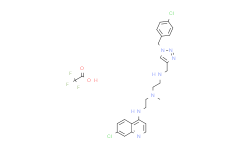| 中文名称: | EAD1 | ||||
|---|---|---|---|---|---|
| 英文名称: | EAD1 | ||||
| 别名: | s8576;1644388-26-0(Free base) | ||||
| CAS No: | 1644388-26-0 | 分子式: | C24H27Cl2N7 | 分子量: | 484.42 |
| CAS No: | 1644388-26-0 | ||||
| 分子式: | C24H27Cl2N7 | ||||
| 分子量: | 484.42 | ||||
基本信息
|
产品编号:E10359 |
|||||
|
产品名称:EAD1 |
|||||
|
CAS: |
1644388-26-0 |
储存条件 |
粉末 |
-20℃ |
四年 |
|
分子式: |
|||||
|
分子量 |
484.42 |
||||
|
化学名: |
|||||
|
Solubility (25°C) |
体外 |
DMSO |
|
||
|
Ethanol |
|
||||
|
Water |
|
||||
|
体内 |
现配现用 |
|
|||
|
<1mg/ml表示微溶或不溶。 |
|||||
|
普西唐提供的所有化合物浓度为内部测试所得,实际溶液度可能与公布值有所偏差,属于正常的批间细微差异现象。 |
|||||
|
请根据产品在不同溶剂中的溶解度选择合适的溶剂配制储备液;⼀旦配成溶液,请分装保存,避免反复冻融造成的产品失效。 |
|||||
生物活性
|
产品描述 |
一种有效的自噬 (autophagy) 抑制剂,在肺癌和胰腺癌细胞中具有抗增殖活性。 |
|
|
靶点/IC50 |
Autophagy |
Apoptosis |
|
体外研究 |
EAD1 (0-200μM; 72 hours) has antiproliferative activity against human cancer cell lines. EAD1 (5-75μM; 24 hours) induces apoptosis in the H460 cells in a concentration-dependent manner. EAD1 (1-25μM; 24 hour) increases the punctate LC3 signal in H460 cells. Cell Proliferation Assay |
|
|
Cell Line: |
H460 and HCC827 nonsmall cell lung cancer (NSCLC) and BxPC3 pancreatic cancer cells |
|
|
Concentration: |
0, 50, 100, 150, 200μM |
|
|
Incubation Time: |
72 hours |
|
|
Result: |
IC50s of 11, 7.6, and 5.8μM for H460, HCC827, and BxPC3 cells, respectively. |
|
|
Apoptosis Analysis |
||
|
Cell Line: |
H460 cells |
|
|
Concentration: |
5, 25, 50, and 75μM |
|
|
Incubation Time: |
24 hours |
|
|
Result: |
Induction of apoptosis. |
|
|
Western Blot Analysis |
||
|
Cell Line: |
H460 cells |
|
|
Concentration: |
1, 2.5, 5, 10, 25μM |
|
|
Incubation Time: |
24 hours |
|
|
Result: |
Caused concentration and time-dependent increases in LC3-II levels. |
|
本计算器可帮助您计算出特定溶液中溶质的质量、溶液浓度和体积之间的关系,公式为:
质量 (g) = 浓度 (mol/L) x 体积 (L) x 分子量 (g/mol)
摩尔浓度计算公式
用本工具协助配置特定浓度的溶液,使用的计算公式为:
开始浓度 x 开始体积 = 最终浓度 x 最终体积
稀释公式
稀释公式一般简略地表示为:C1V1 = C2V2 ( 输入 输出 )








